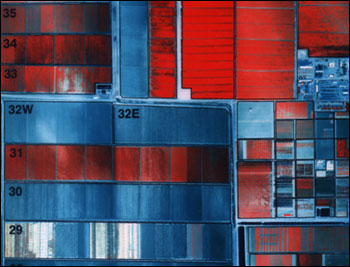| |
Moran explains that a farmer,
like any business person, needs good and timely information to succeed.
To formulate an effective growing strategy, a farmer needs to know three
things: (1) which conditions are relatively stable during the growing
season; (2) which conditions change continually throughout the growing
season; and (3) information to diagnose why their crop is thriving in
some parts of the field and struggling, or even dying, in other parts.
Increasingly, large-scale growers are using information gathered by
aircraft and satellite-based remote sensors to help them gather these
types of information.
Early detection of any change in growing conditions is the key to
good crop management. While there is no match for a farmer’s own
firsthand observations, it isn’t always possible for large-scale
growers to survey all of their lands every week. In addition to
watching out for pests, such as weeds and insects, farmers must also
monitor variables like soil moisture and even plant disease
outbreaks.
|
|
|
| |

A number of scientific studies over the last 25 years have shown that
measurements in visible, near-infrared, thermal infrared, and microwave
wavelengths of light can indicate when crops are under stress (Moran
2000). Using satellite- and aircraft-based remote sensors to precisely
measure the wavelengths of radiant energy that are absorbed and
reflected from the land surface, scientists can diagnose a wide range of
growing conditions. For instance, these data can tell farmers where
their crop is thriving and how efficiently the plants are
photosynthesizing. Alternatively, remote sensing data can tell not only
where, but why, their crop is under stress and help them diagnose
the source.
|
|
This false-color
composite image of the Maricopa Agricultural Center, a research farm in
central Arizona, was acquired in June 1996 by the Daedalus sensor flying
aboard a NASA aircraft. The vegetation growing in the fields is mostly
cotton and alfalfa. Bare fields appear blue, while soils that have
recently been leveled in preparation
for planting appear white. Dark red areas
show flood irrigation (through the crop canopy), which can be seen in the eastern part of field 31. (Image courtesy Susan Moran,
Landsat 7 Science Team) |
| |

Satellites and aircraft have the added advantage of allowing
farmers to survey their entire land in mere minutes. "In the early
days, when farmers had small fields, they knew from practical experience
which sub-areas were wetter and more fertile," notes Craig
Daughtry, a research physical scientist at the U.S. Department of
Agriculture in Beltsville, MD. "But as farms have grown from a few
hundred acres to [as much as] 50,000 acres, farmers start to lose touch
with their fields. Remote sensing provides a fabulous tool for looking
at changes on small scales of space and time."
Once farmers can correctly diagnose exactly where and when there is a
problem, the next step is to correctly apply the treatment.
 At the Right Place and Time At the Right Place and Time
 Precision Farming Precision Farming
|
|
This false-color image
shows the same scene as the image above, but it represents measurements
made at thermal infrared wavelengths of the spectrum, to represent
surface temperatures. Cool temperatures (blue and green) are associated
with vegetation and hot temperatures (yellow and red) with bare soil.
(Image courtesy Susan Moran, Landsat 7 Science
Team) |

